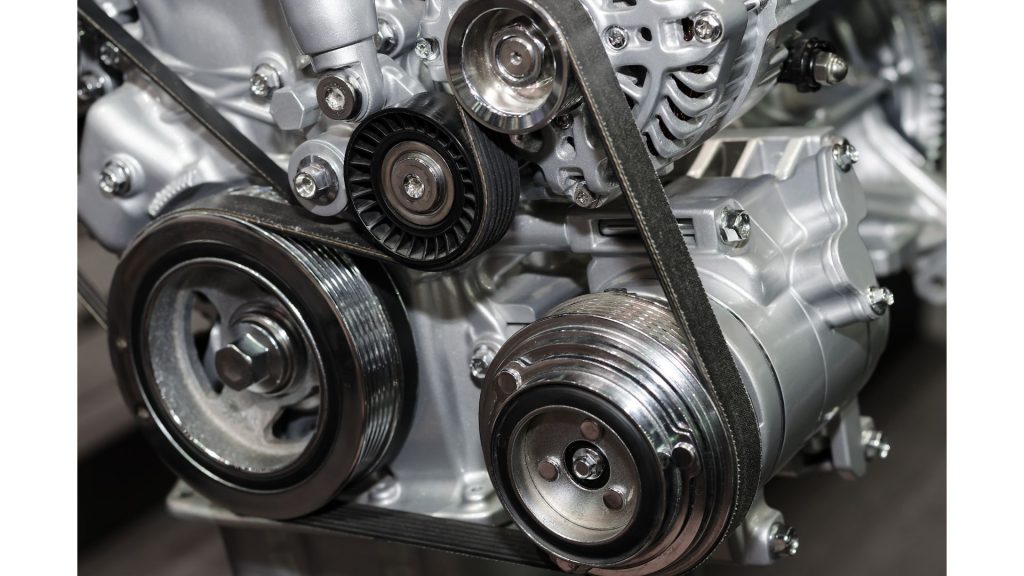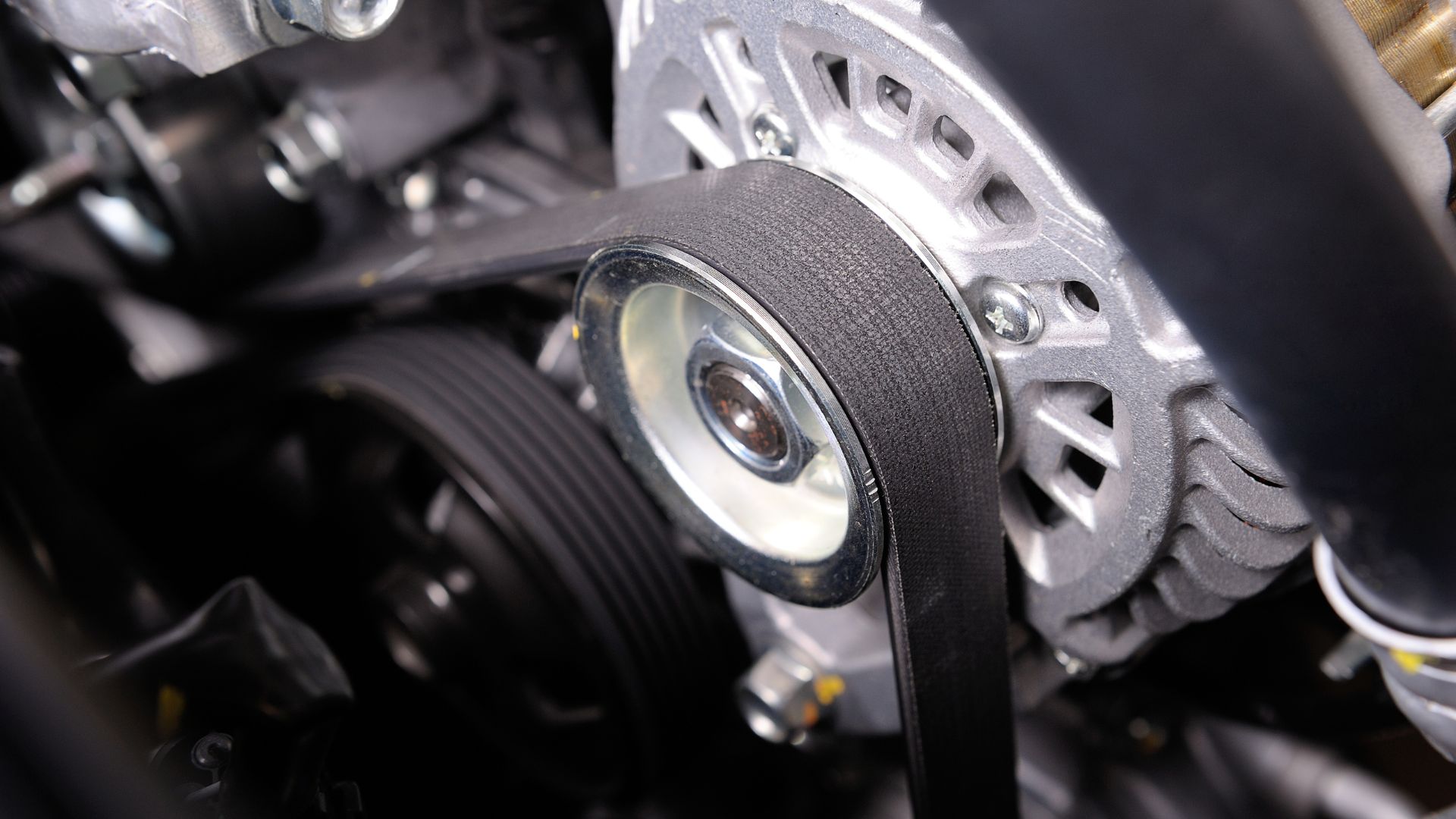Squeaking belts are not just an annoyance. They can attract bigger problems if you ignore them. The guide below will recommend some practical solutions.
Belt Dressing
Belt dressing is fairly common. You can find various brands in most automotive shops. Belt dressing works quickly. You need to spray the inside section while the engine is running. Live About wants you to spray for roughly ten seconds. This should allow you to cover the full length of the belt.
The squeaking will stop instantly. However, this is not a permanent solution. You should take a moment to find the underlying cause of the squeaking.
Pros
- Works quickly.
- Reduces slippage by improving the belt’s grip.
- Reduces friction, which extends the belt’s life in the process.
Cons
- Applying too much belt dressing can make the belt slippery, increasing slippage.
- It makes a mess.
- Belt dressing contaminates the belt and pulleys.
- It is only a temporary solution.
- Removing and replacing the belt will become more difficult.
- It may not work.
WD40
You spray a small amount on the ribbed side while the engine is running. The noise will disappear instantly.
Watch this video from ChrisFix!
Pros
- It can tolerate high heat.
- WD40 is moisture-resistant. It has anti-moisture properties that benefit belts that squeak because of excess moisture on the ribbed side.
- It comes with an aiming nozzle.
Cons
- WD40 is a little pricey for some people.
- This safety guide has classified WD40 as a flammable product.
- It has a strong smell that puts some people off.
- According to Car roar, WD40 is a petroleum-based product (constituting a Stoddard solvent, light oil, and LVP Aliphatic Hydrocarbons) that harms serpentine belts in the long run. Rubber does not like petroleum products.
Candle
You can fight squeaking by rubbing a candle on the sides and bottom of the belt. This requires care and a stable hand because the motor is turning as you apply the wax. If the candle falls out of your hand, don’t panic by reaching for it. Again, the engine is running. You don’t want to incur unnecessary harm.
The candle will fall out of the car from under. Some people worry that candle wax can cause the belt to slip and the pulleys to glaze.
Bar Soap
Some people can’t afford belt dressing and WD40, and they don’t have candle wax on hand. In that regard, bar soap is the next best thing. You rub it on the parts of the belt you can reach to make the belt’s surface smooth.
Don’t run the engine while applying the soap. Unlike the sprays, it is too dangerous to rub the soap on a belt when the engine is running. But again, this is a temporary solution. If your belt is worn out, you can’t fix it by applying sprays and candle wax. Eventually, you must replace it.
What Causes A Belt To Squeak?
You shouldn’t ignore a squeaking belt. After all, this component drives the power steering pump, alternator, and AC compressor. The following factors are usually at fault:
1). Moisture
Wipe the belt with a cloth. Is the fabric wet? You have a leak somewhere. It could be oil. Either way, the fluid will cause the belt to slip, hence the squeaking sound. This problem will persist until you fix the leak.
2). Tension
Check the belt’s tension. Is it too tight or too loose? People answer this question by pouring water on the belt. If the belt is too loose, the squealing will stop, at least momentarily. The belt should have some play (about ¾-inches).
Don’t overcompensate while adjusting the belt by making it too tight. You should leave this procedure to an expert unless you know enough about a fan belt’s tension to make the correct adjustments.
It is worth noting that adjustments of this sort won’t help if you have an old belt. You can’t tighten an old belt enough to stop the squeaking noises emerging from the hood.
3). Glazing
You cannot avoid glazing. It happens after prolonged use. Glazed belts will continue to slip off the pulleys. You can tell that a belt is beyond repair once you notice a reflective sheen on the ribbed section.
You may banish the squeak with a reliable spray. However, the noise will return because the belt can’t maintain a grip. You must replace it. Even if you find a product that permanently resolves the squeaking in cars with glazed belts, these components are inexpensive. You are better off getting a new serpentine belt.
4). Bad Weather
Did you know that bad weather can make a belt squeak? Plummeting temperatures can make a fan belt stiff and tight. This is most prominent on cold mornings when you start the car for the first time. You will hear the belt squeal.
Fortunately, engines are hot, and that heat will eventually alleviate the squealing. You should only panic if the squealing persists.
5). Belt Tensioner
Drivers are usually quick to blame squeaking on an old, worn-out, glazed belt. But what if you replace the belt, but the squeaking continues? Does your car have a hydraulic belt tensioner? This component tensions the drive belt.
You hear squeaking when it fails, especially when the engine is idling. You may also notice rattling sounds.
6). You Made A Mistake While Installation
Did you install the belt yourself? What about the pulleys and tensioner bearings? If so, you probably made a mistake with the installation. Maybe you misaligned the belt, possibly even the pulley system.
You must remove the belt to confirm your theory. Are the pulleys spinning smoothly? Do you hear grinding or any other sound that points to worn-out or damaged bearings? You can’t solve these problems by replacing the belt or applying lubricants like oil and grease.
You need a technical expert to open and diagnose this system to find the problem. They can determine whether the idler pulley is tight enough to support the belt’s tension or if you have coolant on the belt.
There are too many viable sources of squeaking in a car for you to solve this problem alone.
Should I Worry About A Squeaky Belt?
It depends on what has gone wrong. It is easy to blame a cracked, worn-out, or glazed belt for the squeaking under your hood. However, this noise can also originate from faulty pulleys and bearings.
What have you observed? Are any of the lights on the dashboard illuminated? Do you have difficulty steering? This is the biggest concern. The belt is intimately intertwined with the operations of the power steering pump.
As such, if the belt is squeaking from wear and tear, the pump won’t get the power it needs. Can this lead to an accident? You can’t rule it out. Most of you see cars with squeaking belts on the road every day.
Most of those cars reach their destinations safely. This will encourage you to ignore your squeaking belts. But that is a bad idea because you can’t predict your response to heavy steering. What if the steering decides to resist your actions during a critical moment on the road?
Even if you can steer the car successfully, using a squeaking vehicle over long periods can cause additional damage to the pulleys and bearings. You shouldn’t take any chances. But again, it depends on the source of the noise.
A belt that squeaks because of cold weather in the morning shouldn’t concern you. But you won’t know that your car is making noise because the belt is stiff due to the low temperatures. You need to consult an expert.
They will give you the final word on this issue after diagnosing the vehicle. It is worth noting that a car’s engine can overheat if the damaged belt compromises the alternator’s functions. You won’t have peace of mind until a mechanic assures you that your car’s squeaking belt is not a cause for concern.
Is It Safe To Drive If Your Belt Is Squeaking?

For the most part, this practice is not dangerous. At the very least, your car won’t explode or suddenly veer off the road. Some people drive cars with squeaking belts for months without incident.
Accidents are more likely to occur because a broken belt can compromise the power steering pump, which, in turn, can make steering a challenge. Traveling at high speeds in a car that doesn’t turn as effectively as you expect is dangerous.
However, in most scenarios, a noisy belt won’t harm you. At worst, the car will stop working at an inopportune moment, stranding you on the side of the road and forcing you to waste money on a tow truck.
Don’t forget that some vehicles have one belt that turns the steering pump, water pump, and alternator. It is not far-fetched to think that a dead belt can prevent the car from moving. Additionally, you may increase the repair costs by allowing the worn-out belt to damage other components.

